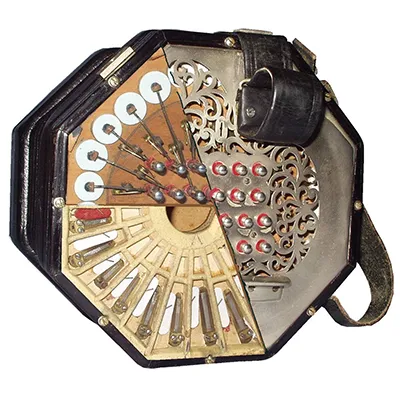 Cut-away image of end-plate, action box and reed pan on an
English concertina. ©️ Dave Elliott
Cut-away image of end-plate, action box and reed pan on an
English concertina. ©️ Dave Elliott
Concertinas were scientifically optimised instruments. Their near-circular shape allowed a highly efficient distribution of bellow-activated brass reeds. The fingering system allocated alternate notes to right and left hands, permiting rapid runs. In accordance with the latest German acoustical theory octaves were broken into fourteen enharmonic tones instead of the usual twelve : G# played as a separate note from Ab, D# and Eb. When Wheatstone concertinas were exhibited at the Crystal Palace in the Great Exhibition of 1851, Hector Berlioz picked them out as having true musical potential, unlike all but one of the other 'abortive and useless' experiments on display (the other exception being the saxaphone) As a composer, however, he was concerned that the instrument's range had not been standardised: some went higher, some went lower, depending on the manufacturer's whim.
A bigger issue was that rival manufacturers of the new instrument patented their own arrangement of notes and buttons. Wheatstone himself marketed two distinct systems, the first ('English') allocating notes on stave lines to the right hand and spaces to the left, the second ('Double' or 'Duet') giving all low notes to the left hand and high to the right. Other manufacturers applied the suck-blow principle of the mouth organ to offer cheaper diatonic 'Anglo-German' or 'Anglo' instruments where the notes played by buttons would change with each shift of the bellows.
Fresh entrants to the market brought their own improvements. John Hill MacCann patented a different ‘Duet’ arrangement in 1898; the Liverpool musical instrument manufacturers Crane & Sons developed their own system, mass-produced for the Salvation Army under the 'Triumph' brand; a fourth Duet system closer to the Anglo was devised by Charles Jeffries and produced from the 1890s; the Wheatstone Company returned to the fray with a fresh re-arrangement in 1950; and Brian Hayden patented yet another Duet system (patent GB2131592) as recently as 1986. The consequence is that apparently identical squeezeboxes are playable only if your fingers happen to be trained on their particular pattern. Any student of the concertina has to choose between ten incompatible operating systems.